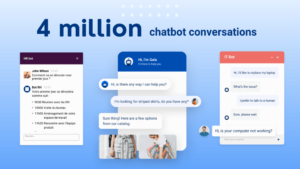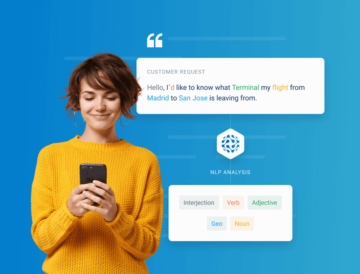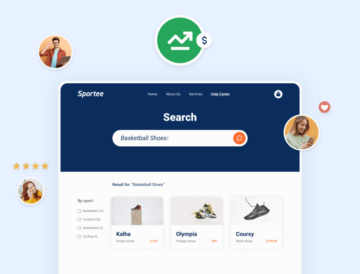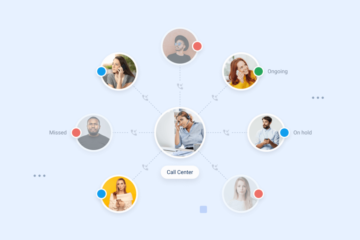Content:
If your company handles support requests, there has surely been a moment when either you or one of your colleagues have thought:
‘What if we offered support through a real-time messaging channel?’
Chat instances are equally loved and feared by support teams.
➡️ On one hand, they provide a more direct customer communication channel, which simplifies resolution times and helps build closer relationships with your customer base.
➡️ On the other, offering a chat channel is of high maintenance, since:
– Customers expect you to answer quite quickly
– There can be peaks of request demands, where your team just can’t keep up
Despite all that, most businesses already understand the value of conversational support and are starting to implement conversational strategies to grow and foster loyalty among their customer base.

Understanding the current state of support quality
Most managers say the quality of customer service is top-of-mind for their companies.
Well, actually data backs up this ‘need’ to really put an emphasis on customer support.
How? Bringing new customers in is extremely expensive. In fact, it is 5 times more expensive than retaining your existing ones.
In spite of that, when we look at the balance of efforts put both for customer attraction and retention by companies, we see that:
🔹 only 18% of them claim to focus most efforts on retention, while
🔹 44% accept they are more focused on attracting new customers
You might be thinking ‘Why on earth are brands not addressing this gigantic elephant in the room’—which by the way is costing businesses in the US as much as 1.7 trillion dollars?
Well, it might be because many don’t even know how much bad support quality affects their financials.
Only an average of 4% of customers complain about support, but that doesn’t mean the rest of the customers have only had great experiences with the brand.
If we consider the Huffington Post study that found out only 1 in 26 customers will actually publicly express their dissatisfaction, we realize we’re facing a much greater problem.
In the end, almost 9 out of 10 people will switch to a competitor after a bad customer experience, so increasing the focus on the type of support your brand provides is beyond important. We could even say critical.
In the last few years, with more and more brands realizing the potential of keeping customers happy, conversational support has become an essential part of growth strategies.

Okay, but… What is conversational support?
Conversational support is a customer service strategy that throws away the idea that customer support should only focus on resolving customer queries. Instead, it aims at building fruitful, long-term relationships with customers using a holistic approach.
By means of real-time communication channels that understand context, brands can build and provide personalized memorable experiences.
The benefits of conversational support include:
🔹 Helping you gather customer data in a frictionless way
🔹 Eliminating contact barriers of traditional contact forms
🔹 Offering a more natural contact environment, letting customers express themselves as they want.
🔹 Speeding resolution times as agents can assist several clients at a time.
So how can you implement conversational support in your business flows?
Top 4 Conversational Support Tips to Increase Customer Loyalty
Leverage chatbots with explainable AI
If we asked you to mention a single technology field that you believe has completely transformed our lives in the past few years, wouldn’t you choose Artificial Intelligence?
In its many forms, AI has simplified our lives. AI can drive for you —Tesla approves—, it can identify diseases sometimes even before a physician, it can monitor and detect fraud with little margin error… And of course, it can write and talk.
Chatbots powered by AI have progressed to enable automated conversations between brands and customers using human natural language.
This helps:
- Reduce support costs
- Automate huge volumes of support requests
- Avoid repetitive low-value queries
- Shorten resolution times
- Enable 24/7 support
Moreover, the initial mistrust towards chatbots has started to dissipate thanks to what we call ‘explainability’. Explainable AI gives full transparency and control of the decisions made by a chatbot, helping brands control the conversation and not the other way around.
Today, 78% of executives are aware of the explainability concept, compared to only 32% back in 2019.
Focus on personalization
No conversational support strategy can thrive without personalization. This buzzword has become one of the focuses of most companies out there.
However, including personalization in your conversational strategy requires planning. Get the necessary tools to extract and save customer data so you can tailor your support answers, the product suggestions you make, and their full customer journey.
You need to choose an AI assistant that can store this data and use it wisely because personalization can make or break your sales strategy. In fact, no less than thirty-three percent of customers that have moved away from brands did it exactly because of a lack of personalization.
With Conversational AI platforms like Inbenta’s, customer data is stored in order to be later reused to personalize customer interactions. Plus, you can even detect customer sentiment to adapt your strategy!

Go omnichannel
If you want your customer support to be truly conversational, the transition from one channel to another needs to be completely seamless.
Imagine you contact your insurance support to ask for the cost of an upgrade using a contact form.
You then get an email back with a price and you decide to go ahead and change your insurance policy. So you go to their website, see they have a chatbot, and decide to reach out.
You type in ‘I want to upgrade my insurance policy’. The chatbot solution implemented should be able to recognize you with little information and pull the data regarding your recent pricing request.
That is what a frictionless experience looks like. Nobody wants to keep repeating what they are interested in and what they want just because they switched channels.
A great customer experience is channel-agnostic.
Provide smooth support escalation
You’ve implemented your conversational support platform, and everything seems to be going great.
You’ve reached:
- High ticket deflection rates
- 90% of your tickets are automatically resolved…
However, your CSAT score is still not awesome. Yes, you’ve seen improvements, but you’re still not where you want to be. Why?
Have you taken a look at the way you hand tickets to your agents? Can your customers easily reach them?
You need to make sure the escalation from a chatbot instance to a live agent is smooth, barely noticeable. Studies show 77% of customers deem the process to reach an agent too long or complex. Some consider this the most frustrating part of the experience. Not the way you solve tickets, not the channels you use, but the escalation process.
Make sure only one agent is assigned, and that your agent is the most appropriate person to answer the user question—remember, you can ask for hints using your chatbot before you actually hand the ticket to an agent. This is the best way to avoid transferring one customer from one agent to another—customers hate that.
Clients and leads will appreciate a smooth escalation process, and you will too!
Looking for the top-performing conversational AI platform?
Get a free tour of Inbenta’s platform now!
Check out our similar articles
Source: https://www.inbenta.com/en/blog/4-conversational-support-tips-to-make-lifelong-customers/
- 2019
- 7
- agents
- AI
- All
- among
- around
- Assistant
- Automated
- BEST
- brands
- build
- Building
- business
- businesses
- call
- change
- channels
- chatbot
- chatbots
- clients
- closer
- Communication
- Companies
- company
- Conversation
- conversations
- csat
- Current
- Current state
- customer experience
- Customer Journey
- Customer Service
- Customer Support
- Customers
- data
- DID
- diseases
- dollars
- elephant
- experience
- Experiences
- Explainability
- Explainable AI
- facing
- financials
- Focus
- form
- fraud
- Free
- full
- great
- Grow
- Growth
- High
- How
- How To
- HTTPS
- huge
- idea
- identify
- Including
- Increase
- information
- insurance
- IT
- keeping
- language
- Long
- Loyalty
- messaging
- Natural Language
- offering
- order
- Other
- personalization
- physician
- planning
- platform
- Platforms
- policy
- price
- pricing
- Product
- Product Suggestions
- quality
- real-time
- Relationships
- REST
- sales
- seamless
- sentiment
- So
- SOLVE
- started
- State
- store
- Strategy
- studies
- Study
- successful
- support
- Switch
- Technology
- Thinking
- time
- tips
- Transparency
- us
- value
- Website
- What is
- years









